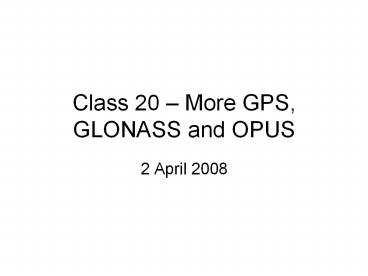Class 20 - PowerPoint PPT Presentation
Title:
Class 20
Description:
How accurate does a clock need to be to achieve measurement precision at the ... operational and one reserve) in geosynchronous orbit, launched between 2000 and 2003. ... – PowerPoint PPT presentation
Number of Views:153
Avg rating:3.0/5.0
Title: Class 20
1
Class 20 More GPS, GLONASS and OPUS
- 2 April 2008
2
Topics
- Homework review/answers
- Recap of GPS range solution
- GPS phase measurements
- GLONASS
- GLONASS/GPS interoperability
3
Homework
- How accurate does a clock need to be to achieve
measurement precision at the millimeter level (lt
1 cm)? - c 299,792,458 meters per second
- c (10e-12 seconds) 0.003m
- What is the orbital period of SV1?
- P2/a34p2/GMe
- a 26,559,122 m Geometric gravitational
constant GMe 3986005108m3/s2 - period (seconds) sqrt((a34p2)/GMe)
- period (hour) 11 hours 58 minutes
4
Homework continued
- How many seconds in a week?
- (days hours in day seconds in hour
seconds in minute) 7246060 604,800 - What is the current GPS week?
- week of 30 March to 5 April 2008 is 1473
5
Signal Processing on-board
6
Frequency to Wavelength
- We can track the phase of the signal and
accumulate the number of wavelengths (and the
fractional first phase) as a measurement. - ? c / f wavelength speed of light divided
by frequency
L1 c/f119 cm L2 c/f2 24.4 cm L5 c/f5
25.5 cm
c 299792458m/s
7
Frequency Combinations
- Narrow-lane f1 f2 11 cm
- Wide-lane f1 f2 86 cm
- Iono-Free f1/(f1-f2) 5 cm
- Why do this?
- Iono-free effectively eliminates this effect
- Other combinations assist integer fixing.
8
Integer bias ambiguity
9
GNSS
- Global Navigation Satellite Systems
- NAVSTAR GPS operational
- GLONASS operational
- Galileo (not yet)
- COMPASS (from The Space Review)
- Chinas existing Beidou navigation network is a
clumsy system based on three satellites, (two
operational and one reserve) in geosynchronous
orbit, launched between 2000 and 2003. 19 June
2006
10
GLONASS
11
GLONASS
- Global'naya Navigatsionnaya Sputnikovaya Sistema
- Intended 21 SV with 3 on-orbit spares
- 3 orbital planes separated by 120 degrees
- orbits inclined 65 degrees
- orbit period 11h 15m
- first launch 1982 most recent 25 Dec 2007
http//www.glonass-ianc.rsa.ru
12
Orbital elements
13
Current March 2K7 Status
14
GLONASS
Note multiple frequencies!
15
(No Transcript)
16
GPS and GLONASS ultra-rapid orbit file
17
Interoperability questions
- GLONASS uses a different geocentric datum (PZ-90)
- GLONASS time and GPS time are not the same.
- Leap seconds are an issue
- Hardware biases
- Use of different frequencies means more
difficulties when fixing integers. - Some broadcast negative frequencies!
18
(No Transcript)
19
(No Transcript)
20
(No Transcript)
21
GPS only planning
Nsats Number of satellites PDOP Position
Dilution of Precision
22
See G19 that sets at 2330 and rises again at
0530 (6 hr period)
23
SKYPLOT
24
Dilution of Precision
- A planning measure measuring the effect of
satellite geometry wrt the satellite
constellation. Smaller values are better. - PDOP Position (East, North and Up)
- GDOP Geometric (E,N,U and Time)
- VDOP Vertical (Up)
- TDOP Time (Time)
- DOP combined with UERE to estimate positioning
accuracy.
25
Short Occupation Times
26
(No Transcript)
27
VDOP
28
Best VDOP
29
GPS Baselines
30
OPUS Solution Extended Output
31
GPS Antenna Calibration Issues
Obviously, GPS antennas have different physical
dimensions. Less obviously, they track the
satellites differently. Note the different
values for the same elevation angle for these two
antennas.
32
Absolute Antenna Calibrations
Required reading IGSMAIL-5189 Planned changes
to IGS antenna calibrations http//igscb.jpl.nasa.
gov/mail/2005/msg00111.html
33
(No Transcript)
34
This is NOT JCAD 28. It is a tidal station near
Rainbow Bridge. It is not yet in the NGS data
base.
35
(No Transcript)
36
These three G-file sections show (line C) the
baseline components and their standard deviations
for the three ties to CORS sites. The D line
shows the correlations between baseline
components (DX to DY, DX to DZ and DY to DZ).
37
(No Transcript)
38
(No Transcript)
39
(No Transcript)































